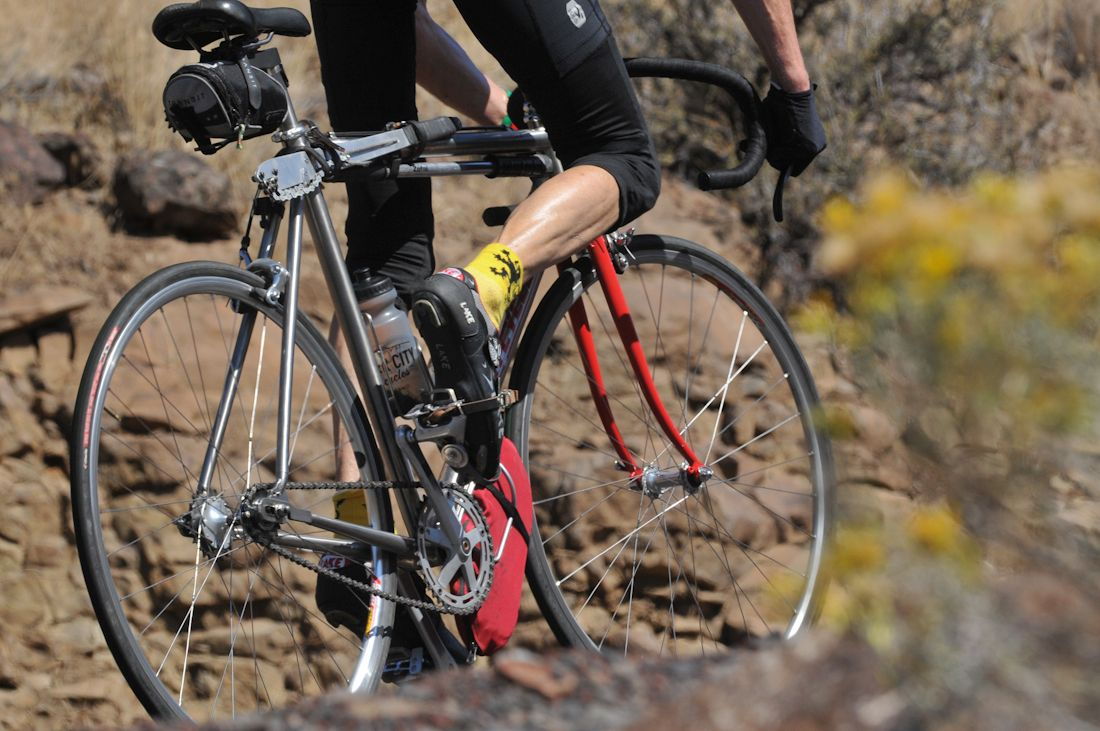Originally Posted by
rustystrings61
I live in rolling terrain in what the local real estate types have taken to calling The Lakelands of South Carolina. When I rode ss mountain bikes on the area's trails (they're a lot of fun!) I ran 34x17, yielding around a 48-in gear on the 2.1-in Panaracer Fire tires I used to use.
For fixed-gear I've been primarily running around 70-71 gear inches on the road since 1998 or so. It was 48x18 on my old Bianchi Pista, 45x17 on my beat-but-sweet old Gitane TdF, and 42x16 on the Peugeot PR-10, Falcon San Remo, '71 Raleigh Competition and the custom Mercian. When I started adding fire roads to the equation I fitted a larger cog on the other side of the hub, typically around 63 inches. I think I rode just about every dirt road in this county and a bunch of them in neighboring counties on a 42x18 on 28mm tires.
My current all-road mad scientist bike is a 50-year-old Raleigh Competition with 35mm tires, a Surly Dingle fixed cog and a White Industries Dos Eno freewheel on the other. Combined with 42/44T chainrings, I get 70-in pavement and 60-in gravel fixed gear options, or I can flip the wheel and have a 60-in general noodling and a 52-in mild singletrack option for coasting.
There was a time when it was expected that races would come to a stop and everyone would flip their wheels for the upcoming hill. I embraced that concept when I ordered my avatar photo bike. That bike will never be anything but a fix gear but it runs a double sided hub and has a modified road-style horizontal dropout long enough that I can run any available 1/8" cog without messing with chain length. (!2 teeth to 24.) I didn't think this out specifically but the bike is basically what we might have used for a late 1980s road race in a world where gears had never been invented so the rules were - velodrome style nutted rear hub, fix gear, brakes required front and rear.
I received the frame from TiCycles December 2011. That January, Cycle Oregon unveiled their week-long route. To Crater Lake. 6 of the 7 days had big climbs but save for the Crater Lake day, only one. And one big descent. Hmmm. Not many wheel flips! But I gotta have a big gear! So I made the chainwhip you see strapped to the top tube. 22" long so lots of leverage but only 20 ounces. That photo was taken two years later on CO. That was a two mile hill that maxed at 14.5% where the photo was taken. (Credit Cycle Oregon's Dean - a super photographer.)

That day I left camp on the 17 with the 23 on the other side. Used the 17 going over a pass earlier and the 12 on the other side. Planned to do the two small hills after lunch on the 17 and flip for the biggie. Oops! I was well into the biggie before I figured out "this is it!". Too steep to stop and start again in hundreds of Cycle Oregon bikes' traffic. So that 14% was done on a 42-17. The tIght muscles on my calf and forearm were not for show. (You can see the 12 tooth cog hanging from the tool bag and the Pedros Trixie tool under the bag. (The spanner on the Trixie is a superior lockring spanner for the bell shaped 12 tooth lockrings. Wide enough that it never slips, unlike the spanners made from plate like most of the Park's.)
The dropout is one of the best parts of the bike. Around 2" long. Angled up at the back 11 degrees, roughly half a regular dropout that maintains constant brake pad location on the rim as you slide the wheel but mine close enough the the pad stays on a deep rim (and is most marginal when the wheel is all the way forward. I am not going to be doing any hardcore descents and doing serious braking in a 42-24 gear. Bottom bracket drop is minimal with the wheel slid all the way back in the 12 tooth cog to keep pedaled 40 mph corners as boring as possible with 175 cranks - my knees insist. (BB height is around 10 7/8". Good and high. Seat tube angle is 75 degrees and a 25c tire nearly hits it with the wheel all the way forward, again to keep the 12 tooth positioning as far forward and bike handling as boring as possible. All a compromise, yes, but a very, very good compromise! Bike is a pure joy to ride. Crate Lake was a blast!
And back to the dropout. Notice the slot is "L" shaped; that it runs forward then opens down like a vertical dropout. Opening forward - makes wheel flips easy. No tight chain you have to wrestle off the cog if you put on a huge one for that hill. And opening down? No clearance between the tire and seat tube with a big cog but opening down, there doesn't have to be. Between that dropout and the chain peg and using the Trixie tool, wheel flips take no more than 2 minutes and my hands stay clean. (Changing a cog with the chainwhip takes about 5 minutes.
And last - a question - why isn't every road fix gear set up like this? Nothing here is rocket science or requires special parts. The dropouts were cut from 1/4" plate. The chain peg is an M5 pan head screwed into a tapped hole in that plate. All perfectly do-able 150 years ago. (I don't know when threaded cogs and lockrings came into being but that was long ago, probably after the first automobile but maybe before the Model T. Track ends on the road? Why?